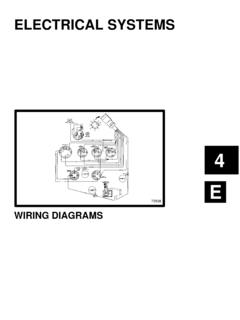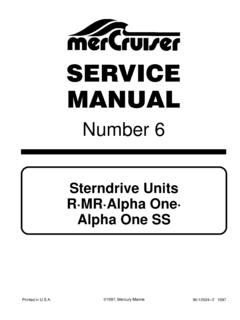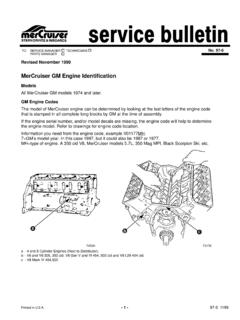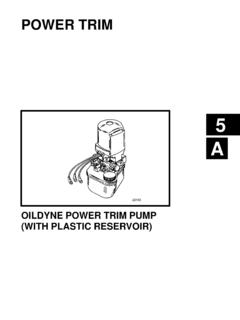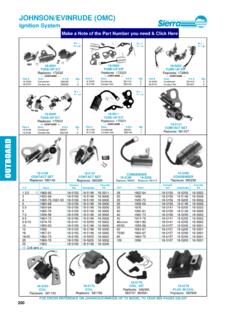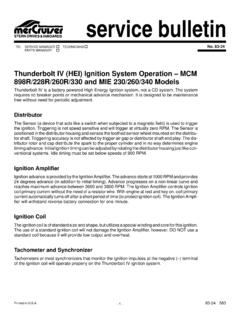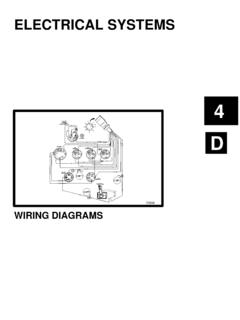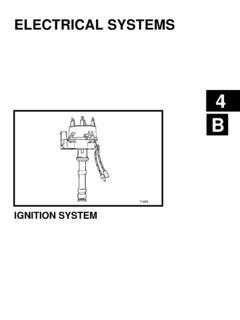Transcription of Gasoline Engine Vapor Locking - boatfix.com
1 No. 99-7. WARRANTY INFORMATION SERVICE INFORMATION. = Revised November 2001. Gasoline Engine Vapor Locking Models All Mercury MerCruiser 4 Cylinder, V6 and V8 engines. Situation Under certain conditions, engines may experience a Vapor lock' condition. The three most common complaints that Vapor Locking cause are: 1. The Engine starts. When the throttle is advanced, the Engine quits running and will not restart. 2. If the Engine does restart, it quits when advancing the throttle to get the boat up on plane or to pull up a water skier. 3. After running the boat and shutting the Engine off for 1 to 3 hours, the Engine does not want to restart. Conditions That Affect Vapor Locking Fuels containing alcohol and winter grade' fuels will cause Vapor Locking complaints to increase. NOTE: The new Reformulated' fuels have the RVP (Reid Vapor Pressure) very carefully controlled. It will normally take several following conditions to make an Engine Vapor lock'.
2 These con- ditions include but are not limited to: 1. Type, formulation and RVP of the Gasoline in the boat's fuel tank or sold in the area. Win- ter grade' fuels sold from October through March in most areas have the highest RVP. 2. Engine compartment air temperature and its ventilation system. 3. Temperature and vacuum on the fuel that is being delivered to the Engine . 4. The location of the fuel tank. 99-7 NOVEMBER 2001 Printed in - 2001, Mercury Marine Page 1 of 6. Gasoline Engine Vapor Locking . 5. The boat's fuel supply system. This includes Inside Diameter (ID) of fuel line and fittings, fuel line length, routing, bends or kinks and the clamps that secure it. Extra fuel filters, fuel manifolds, anti-siphon valves, shut off valves, tank selector valves and the number of 90 degree fittings used. 6. Engine coolant temperature. 7. How quickly the Engine is shut off after running at cruising or higher rpms and how long the Engine and Engine compartment are allowed to cool off after use.
3 8. The outside air temperature on the day the boat is being operated. Corrections That Can Be Done To Help Minimize Vapor Locking Before looking at the customer's problem as a Vapor Locking condition, make sure some- thing else is not causing the running problem. Air leak in the Engine or boat fuel system. Check the tightness of all fuel fittings and clamps. Check for a cracked housing where a brass fuel fitting is threaded in it. IMPORTANT: Do not pressurize the boat's fuel tank(s) in this test. Disconnect the fuel line from fuel tank(s). Pressurize the fuel system that goes to the en- gine to 8 psi (55 kPa) with a hand pump to see if it holds this pressure. Often systems will leak air but not fuel. Always use a wrench to hold a brass fitting that is threaded into an alumi- num casting when tightening another fitting threaded into it to prevent the casting from cracking. Check the complete fuel supply system of the boat for a fuel restriction.
4 Include the brass fitting threaded into the Engine 's inlet in this test. Use a portable outboard fuel tank con- nected directly to the Engine 's fuel inlet fitting as a quick way to test the system. If these more common problems are not causing the complaint, then continue. 1. Follow instructions below: a. Find out what type of fuel is in the boat's fuel tank. Fuels containing alcohol are more likely to Vapor lock on hot days. b. Find out what the RVP of the fuel in the boat's fuel tank is. 11 to 15 RVP (cool to cold weather) fuel will change from liquid to a Vapor at lower fuel temperature than 8 to 10 RVP (warm to hot weather) fuel will. Refilling the boat's fuel tank with lower RVP. fuel will decrease the chance of Vapor Locking . Fuels purchased in most areas of the USA from late September through early April will cause most of the problems. 2. Follow instructions below: a. Over the last several years, Engine compartments have been designed to be quieter.
5 This is done by using an insulation material and by making Engine covers' tighter. This can cause high air temperature inside the Engine compartment while the Engine is operating and for a period of time after it is shut off. This period of time is called the heat soak' time. The air temperature inside the Engine compartment during a heat soak' will rise higher than during the Engine 's running time'. This is because there is no air movement inside the compartment and no coolant flow through the Engine . Normally, the quieter the Engine compartment is, the hotter the air tempera- ture will be on the inside during the heat soak'. The highest air temperatures during a heat soak' will occur 30-40 minutes after the Engine is shut off and can stay at that peak for up to 1-1/2 hours. This greatly increases the chances of Vapor Locking . Page 2 of 6 NOVEMBER 2001 99-7. Gasoline Engine Vapor Locking .
6 B. Mercury MerCruiser Engine compartment air temperature specification that became effective January 1, 1996 is: Under the hottest outside air temperature condition that the boat will be operated in, the maximum air temperature inside the Engine compartment, measured at the flame arrestor, shall not exceed 176o F (80o C). c. Increasing Engine compartment ventilation to move the hot air out of it during a heat soak' will decrease Vapor Locking . Other items that can help reduce Vapor Locking are: Letting an Engine idle for 3-5 minutes before shutting it off. Open the Engine cover to let the hot air escape. Operate the bilge blower to remove the hot air. 3. Follow instructions below: a. Fuel temperature (at the Engine 's fuel inlet fitting) and the amount of vacuum required by the fuel pump to draw the fuel from the boat's fuel tank can contribute to Vapor Locking . Mercury MerCruiser's maximum Engine fuel temperature specification that became effective January 1, 1996 is: Under the hottest outside air temperature condition that the boat will be operated in, the temperature of the fuel being supplied to the Engine shall not exceed 110o F.
7 (43o C) at any location between the fuel tank and the Engine 's fuel pump. Mercury MerCruiser's specification for the maximum vacuum measured at the fuel inlet of any MerCruiser Engine is: 2 in. Hg (7 kPa) maximum at idle rpm, 3000, full throttle and back at idle rpm. Use an accurate digital vacuum gauge that reads in either in. Hg (inches of mercury). or (kPa) to check this specification. Common vacuum gauges to check an Engine intake manifold vacuum are not accurate enough to make this type of measure- ment. b. Reducing the temperature and maximum vacuum of the fuel being supplied to the Engine will help reduce Vapor Locking problems. NOTE: Carbureted and EFI/MPI with VST models only: The Water Separating Fuel Filter can be removed from the Engine to a lower, cooler location. Use a Coast Guard approved fuel line between the filter and the fuel pump. 4. Check to see if the fuel tank is in an area where Engine compartment heat or sun can preheat the fuel that is in the fuel tank.
8 Putting insulation between the fuel tank and the heat source can help keep the fuel cooler. 99-7 NOVEMBER 2001 Page 3 of 6. Gasoline Engine Vapor Locking . 5. Follow instructions below: a. The fuel supply system can be a major cause of Vapor Locking . Remove all kinks in any of the fuel lines. Move the fuel line to be as close to the bottom of the boat as possible to keep it in the coolest area of the Engine compartment. Replace clamps used to support the fuel line with larger clamps if the fuel line is being pinched or constricted with the current clamp. b. Reduce the total length of the fuel line to be as short as possible. Eliminate or reduce the number of 90 degree fittings used in the system to no more than 2. c. Any anti-siphon valve or restriction that causes a higher than specified vacuum reading can contribute to Vapor Locking and other driveability problems. If the vacuum reading is too high, try a less restrictive anti-siphon valve or the Electric Anti-Siphon Valve Kit.
9 NOTE: An Engine that has a Vapor Locking condition may show a very low vacuum reading. This could be a false reading because Vapor can give a very low vacuum reading. Check the inlet fuel line to ensure that a good solid flow of fuel is in the line instead of a mixture of fuel and vapors. As a test only, use a clear plastic hose between the Engine and the supply line to look at the fuel flow visually. d. Going to the next larger Inside Diameter (ID) fuel line and fittings can help lower the vacuum and help correct Vapor Locking conditions. An example is shown below. 5/16 in. (8 mm) fuel line and fittings ID in. Hg ( kPa), too high. 3/8 in. ( mm) fuel line and fittings ID in. Hg ( kPa), too high. in. ( mm) fuel line and fittings ID in. Hg ( kPa), good. NOTE: Engines with 3/8 in. ( mm) ID fuel line and 15 ft ( m) total length or less: Going to a in. ( mm) ID fuel line will not give much improvement.
10 Fuel systems longer than 15 ft ( m) may see an improvement by going to in. ( mm) fuel line and fittings. e. Mount fuel manifolds as low as possible in the Engine compartment to lower the fuel temperature or remove them if possible. 6. Follow instructions below: a. Make sure that the Engine has the correct degree thermostat in it. Replace with the correct one. b. Keep fuel lines as far away from Engine cooling hoses as possible. Page 4 of 6 NOVEMBER 2001 99-7. Gasoline Engine Vapor Locking . c. EFI and MPI engines with the Cool Fuel' system should have the fuel cooler temper- ature measured after the Engine is shut off. The coolant hose going to the fuel cooler' should not get much hotter to the touch after the Engine is shut off for 10-20. minutes than what it is with the Engine running. If it gets hot after the Engine is shut off, hot water from the cylinder block might be siphoning back.
